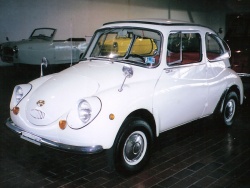 1966 Subaru 360. Click image to enlarge |
Article and photo by Bill Vance
Like most Japanese automobile manufacturers, Subaru didn’t start as a car company. It dates to the 1917 establishment of the Aeronautical Research Laboratory by Chikuhei Nakajiama in Ota City, Japan. It became Nakajiama Aircraft Co. in 1931 and built airplanes until the end of the Second World War.
After the war Nakajiama Aircraft was re-organized as Fuji Sangyo Co. to build products like bus bodies and engines. In 1950 the occupying Allied forces broke the company into 12 smaller firms, six of whom reunited three years later to become Fuji Heavy Industries. Fuji grew into a large enterprise engaged in aircraft, ship building, railways and containers, and a motor scooter called the Rabbit.
Fuji’s vehicle arm, called Subaru, was named after the Pleiades group of six stars in the Taurus constellation of Greek mythology. The six stars in the Subaru badge were inspired by this mythological origin, and represented the six companies in the Fuji conglomerate.
Fuji progressed to cars in 1958 with the Subaru 360, a tiny four passenger vehicle with two rear-hinged, “suicide doors.” A rear-mounted two-stroke, two-cylinder, air-cooled, 356-cc engine drove the rear wheels through a three-speed, later four-speed, manual transmission. It had four-wheel independent torsion bar suspension.
Engine displacement was kept below 360 cc to qualify for Japan’s “360 Class” that was lightly taxed, exempt from the government’s regular rigorous inspections, and subject to strict overall size limits. They were usually a family’s first car after a motorcycle and sidecar.
Although popular in Japan, Fuji was reluctant to export the 360 to America because it thought meeting U.S. safety and emissions regulations would be too costly. An entrepreneur named Malcolm Bricklin changed that.
Bricklin was already importing Rabbit scooters so he had an association with Fuji. He was interested in Subaru cars and discovered what Fuji had missed: a vehicle weighing under 454 kg (1,000 lb) wasn’t considered a car, and was exempt from emissions and safety regulations.
In the late 1960s Bricklin and partner Harvey Lamm formed Subaru of America, Inc., located in Philadelphia, Pennsylvania, and began importing 360s in 1968.
While the Subaru 360 was accepted in Japan, North America’s big car culture was a different environment. The 360 was even smaller than the British Motor Corporation’s Mini, considered something of a microcar in the U.S. and Canada. The 360’s wheelbase was 229 mm (9 in.) shorter than the Mini’s 2,032 mm (80 in.), and its 2,995 mm (117.9 in.) length was 61 mm (2.4 in.) shorter. At 444 kg (980 lb) it weighed 163 kg (360 lb) less. And the 360 could not be called stylish; as Road & Track (3/’69) said, “The car itself is of uncommon ugliness…”
Not only was the Subaru 360 tiny, performance was modest to the point of being dangerous. R&T reported a 90 km/h (56 mph) top speed, barely enough to keep up with slower traffic, at which the tiny 25 horsepower engine was screaming at over 5,000 r.p.m.. R&T reported agonizingly slow zero to 80 km/h (50 mph) time of 36.7 seconds.
Bricklin and Lamm promoted the 360’s low price and high fuel economy, a difficult sell in the land of cheap gasoline. They managed to establish several Subaru dealers in Pennsylvania and neighbouring states, and as far west as California.
The 360’s sales were modest until Consumer Reports magazine called it “The Most Unsafe Car in America,” then they died completely. Dealers refused any more cars, and Subaru of America’s bankers started pressing for loan payments.
Bricklin was desperate. He asked Subaru for a larger car, and sought new financing. A deal was finally made, but it was designed to push Bricklin out, and a 1971 settlement gave Bricklin, in part, 1,000 unsold 360s.
Bricklin found another investor and formed FasTrack International Inc., to sell franchises which included 10 Subaru 360s and the right to build small tracks for rented 360s to race on. The investor, Leon Stern, soon found his money going to unrelated enterprises. He sued Bricklin and was awarded a $4 million judgement in 1974.
Although the Subaru 360 slid into obscurity, Subaru overcame its tarnished reputation and produced a line of well respected cars and a loyal customer base. With Lamm’s guidance, and later its own American subsidiary, Subaru established a strong North American presence.
Malcolm Bricklin, ever the promoter, went on to other things, including the Bricklin, a star-crossed, New Brunswick-built gullwing sports car. Before production ended in 1975, the province had lost $23 million on the venture.







 Follow Autos on Twitter
Follow Autos on Twitter
